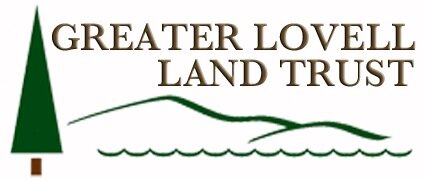The Giving Power of the Forest
BUILDING CONNECTIONS FOR OUR NATURAL AND HUMAN COMMUNITIES
Tom Henderson, Executive Director, Greater Lovell Land Trust
FROM THE 2017 EDITION OF LAND, LAKES & US MAGAZINE
Our predecessors understood and depended upon the giving power of the land. They valued every acre for what it could provide. Forests supplied building material and fire wood. Woodland yielded to pastures that returned milk, wool, meat and eggs. Stewarded fields produced life-sustaining crops and forage for farm animals. Family farms often retained a “back forty” wood lot for game, berries and nuts, lumber and firewood. Granite for foundations and mill stones was cut from boulders and ledge outcrops and every farmer held close the location of the prized hornbeams, used for tool handles of all shapes and functions. The giving power of the land was acknowledged and respected.
Today we are less linked to the land and our appreciation for its giving power has waned. The conversion of land for box stores and malls may seem to be a best use that many perceive as a giving power. The reality is that we are as dependent upon undeveloped land today as we have ever been. Our need for agricultural lands to produce the foods we eat is obvious, but perhaps less evident is the need for forests.
Humans are forest-dependent. Forests provide for clean drinking water, are the source of products that we use every day, and they are natural playgrounds full of rich and enjoyable outdoor experiences that enrich our spiritual and physical well-being. Native wildlife thrives in the forests, sustaining the delicate, interconnected, and interdependent web of life. Our forests support the local economy with jobs in guiding, maple syrup production, logging, milling, and artistic pursuits in the creative arts. The giving power of our forestland is powerful.
Forest cover also plays a critical role in maintaining the water quality in our watersheds. Trees soften the impact of rain drops on the earth slowing erosion and absorption in the forest soils and allowing storm water to filter gradually through the soil to find its way to ground water aquifers and surface drainages. Studies of New England drinking water supplies suggest that water quality begins to decline when as little as 15% of the forest in the watershed is converted to other uses. Maintaining healthy forest cover in a watershed is the cheapest and most effective way to minimize the need for water treatment and deliver our most basic need—clean drinking water.
It’s been said that at any given moment, for any given person, there are eight forest products within a their reach. There is a vast array of forest products
that we rely upon to make our lives easier. Trees provide wood for buildings, furniture, tool handles, pencils, toothpicks, popsicle sticks, paper (for magazines like this one), packaging, boxes, car components, firewood, pine nuts for your pesto, and maple syrup for your pancakes. Chemical by-products from trees are used in manufacturing of clothing, plastics and yes, even in the pernicious plastic grocery bags that you may choose over paper bags.
Large forested areas provide for these traditional uses and present rich outdoor experiences for the people of our local community. These are the places we choose to hike, camp, hunt, fish, snowmobile, ski and see the native wildlife. It is where we connect with nature by our immersion in it. Time spent in the forest has the power to excite the spirit in all of us and calm the soul within. Recreation is when we re-create ourselves.
The health of a forest system requires a full complement of native wildlife, and the viability of wildlife populations requires the freedom of unimpeded movement of individuals and sub-populations across the landscape. The effectiveness of the forest to support the diverse species that need large ranges or that are deep forest dwellers is dependent on two key factors: size and connectedness. Large forest parcels of 500, 1,000 or even 2,000 acres are limited in their ability to support complete native wildlife populations if they are cut off from other forest by land that has been converted to agriculture, development or roads.
Consider that a male black bear requires up to 60 square miles of quality habitat, and a moose will range 5-50 miles at different times of the year. Quality home range habitats permit individuals to survive, but safe passage and freedom of travel by individuals in a wild community allows genetic dispersal that strengthens the ability of entire populations to thrive. Where healthy and expansive forests persist, native wildlife thrives.
The Greater Lovell Land Trust is in its 35th year of working to protect and preserve the natural world in this region. Partnerships with private landowners who wish to preserve their land voluntarily have resulted in nearly five thousand acres of habitat protection. The focus of the land protection program is on building the connectivity between conserved habitats. By connecting adjacent large blocks of forestland in a north-south fashion and topographically from lowland to ridge-top the stewardship of the wildlife habitat is broadened. The connections also provide recreational access for the community across long reaches of land.
Like those that came before us, we strive to understand, appreciate and respect the giving power of the land. We are committed to maintaining and protecting a healthy and vibrant ecosystem for the benefit of our human and natural communities now and in the future.

